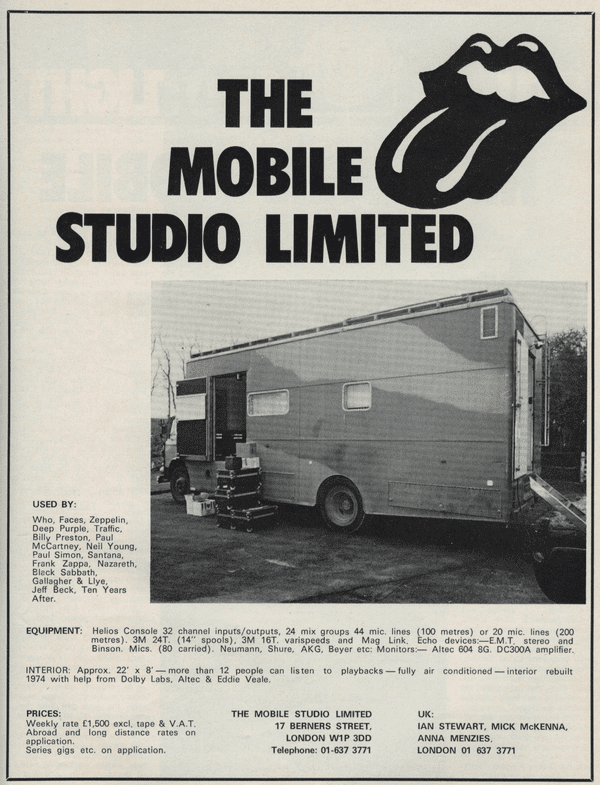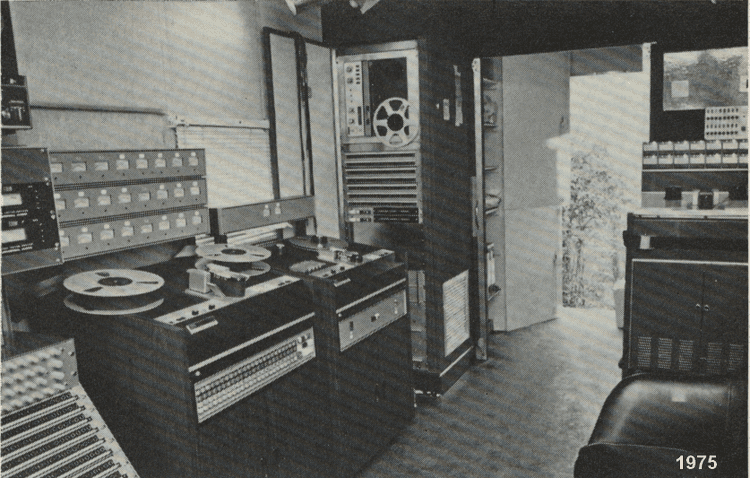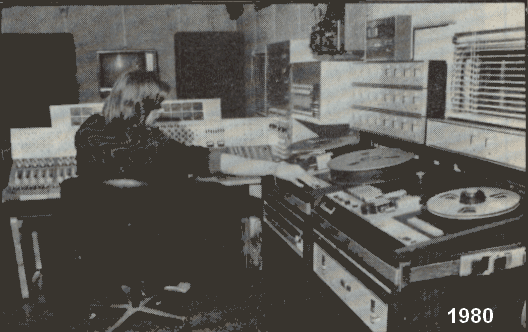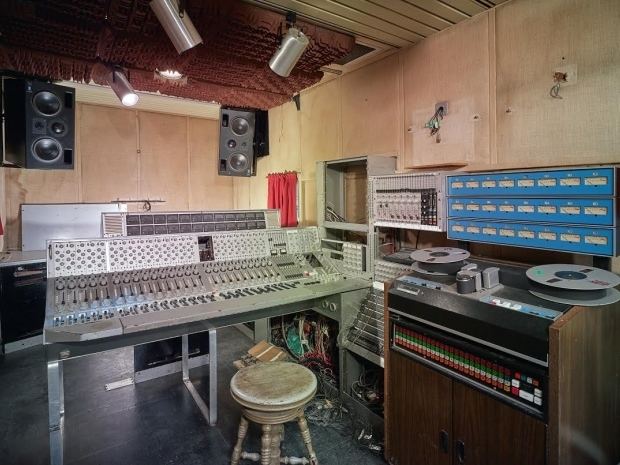 | ||
Similar Jimmy Miller, Ian Stewart, Chris Kimsey, Nicky Hopkins, Bobby Keys | ||
Rolling stones mobile studio at nmc
The Rolling Stones Mobile Studio was a mobile recording studio owned by the English rock band The Rolling Stones. Numerous bands and artists have recorded music using it, including Dire Straits, Deep Purple, Lou Reed, Bob Marley, Horslips, Fleetwood Mac, Bad Company, Status Quo, Led Zeppelin, Iron Maiden, Wishbone Ash and the Rolling Stones themselves. More recently, the unit has been acquired by a museum in Calgary.
Contents

History

The concept for The Rolling Stones Mobile Studio first came about in 1968 when the Rolling Stones decided they needed a new environment in which to record music. Tired of the 9-to-5 limitations of a regular studio, the Stones decided to use Mick Jagger's new country house (Stargroves) in England to record new music. All the necessary equipment had to be brought to the house, so the idea of putting a control room into a van was brought up by their road manager and pianist Ian Stewart.

Under Stewart's guidance, a variety of top engineers and producers, including Glyn Johns, were consulted in the project's creation, which was then taken to Dick Swettenham's company Helios Electronics. Known for making mixing consoles for some of the most exclusive studios of the time, the company then produced the first working version of The Rolling Stones Mobile Studio. Originally only intended for use by The Stones, the unit soon gained popularity among the likes of other classic rock bands, such as The Who, The Faces, and Led Zeppelin.

Originally the unit supported a maximum of 20 inputs and had an eight-track recording format. As the Mobile began to be used for live recording, the eight-track format quickly proved insufficient and an upgrade to 16-track took place.

Several classic albums were recorded with the Mobile Studio, including most of Led Zeppelin's Led Zeppelin III (1970) and Led Zeppelin IV (1971), much of the Rolling Stones' Sticky Fingers (1971) and Exile On Main St. (1972), as well as the Stones' 1969 Hyde Park concert. The unit was used in a large variety of locations, everywhere from halls to barns to castles and the casino at Montreux, Switzerland. During the making of the sixth Deep Purple album, Machine Head, the Mobile nearly caught fire as it stood next to the casino, which was set ablaze during a Frank Zappa concert. This incident became the inspiration behind Deep Purple's most famous song, "Smoke on the Water", where Ian Gillan mentioned the Mobile in the lyrics ("We all came out to Montreux ... to make records with a mobile") and later referred to the Mobile as the "Rolling truck Stones thing".

During Spring 1973 (until 1976), Tapani Talo (aka Tapanainen) was hired to be the permanent assistant sound engineer for the mobile.
During The Rolling Stones 1973 European Tour Mick McKenna joined the company, and working with Ian Stewart until his death in 1985, undertook the future development of the unit to suit the changing patterns of work. The next couple of years saw a great deal of re-building and general upgrades to the Mobile. The 16-track recorder was upgraded to a 24-track recorder, 12 new inputs were added to the existing 20, and a large amount of work was done to improve the acoustic environment of the unit.
By the 1980s the pattern of work had shifted towards more broadcast oriented products, mostly for major UK clients such as LWT, BBC, Capital Radio, Tyne Tees Television and others. This prompted the inclusion of a synchronizing computer in 1982. This computer enabled audio and video tapes to be run in perfect time, which allowed the Mobile to record a show and then provide finished audio ready for transmission. This feature made it possible to provide the entire sound for several TV series incorporating such artists as Miles Davis, Willie Nelson, Paul Young, and The Chieftains.
In 1987 Bill Wyman created the Ambition Invention Motivation Success project (or the AIMS project) which was a vehicle to give young bands all around the country a chance to work out of the Mobile Studio and produce a top-quality demo. The blue livery and yellow sign writing were applied as the colors of the project’s sponsor Pernod. Producers Terry Taylor and Mick McKenna worked on about 60 tracks during the course of the project, which culminated with a final show at the Royal Albert Hall in February 1988.
The Mobile was subsequently returned to the commercial marketplace which had become extremely competitive, both financially and technically. It remained in operation until its closure in April 1993. The last recordings made by it were with Mick's brother Chris Jagger, and his band Atcha!, at the unit's base in Pinewood Studios.
In 1996 The Mobile, still in its original form, was sold through auction at Bonham’s and brought to the U.S. by Loho Studios in New York City. After a bit of technical service, it was put into action in the underground music scene in New York, making recordings including live performances of Patti Smith, The Ramones, and nearly 30 other bands at the Continental for the "Best of NYC Hardcore" album.
The unit is currently owned by the National Music Centre in Calgary, Alberta, Canada (Cantos Music Collection acquired it in November 2001).
